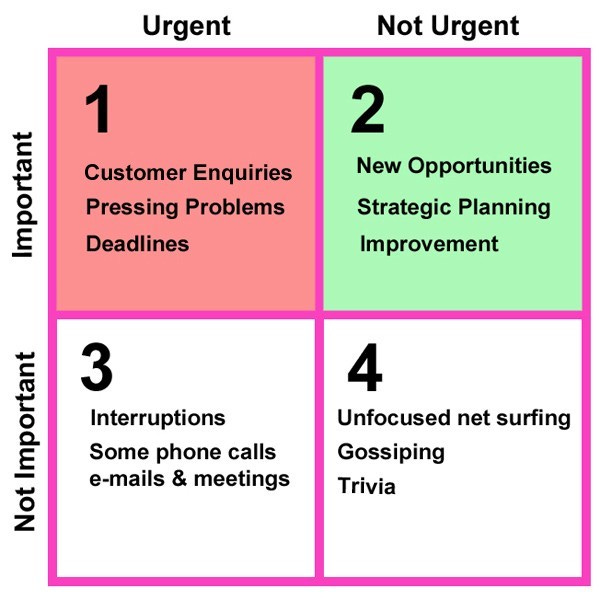👋 Hey, Kyle here! Welcome to The Influential Project Manager, a weekly newsletter covering the essentials of successful project leadership.
Project Managers and leaders everywhere know that time is the most precious asset there is. We will often negotiate and even fight over food, oil, land, money, and water, but we treat time like it will, well, last forever. In reality, it’s the only non-renewable resource we have.
In this week’s piece, I want to share a productivity tool that will change the way you view tasks and time. It’s called “The Eisenhower Matrix.” I first learned about this tool at a leadership training seminar hosted by the company I work for. Since then, I’ve been able to accomplish more in less time and gain more control of my desired outcomes.
The Eisenhower Matrix was created by Dwight D. Eisenhower - the 34th President of the United States and a five-star general during World War II.
In a 1954 speech, Eisenhower quoted an unnamed university president when he said, “I have two kinds of problems, the urgent and the important. The urgent are not important, and the important are never urgent.”
Stephen Covey, author of The 7 Habits of Highly Effective People, took Eisenhower’s words and used them to develop the now-popular task management tool known as the Eisenhower Matrix.
The Eisenhower Matrix is a task management tool that helps you organize and prioritize tasks by urgency and importance, so you can effectively prioritize your most important work. I like to reference it as the blueprint for productivity and can serve as your roadmap to productive action.
This tool helps you divide your tasks into four boxes: the tasks you’ll do first, the tasks you’ll schedule for later, the tasks you’ll delegate, and the tasks you’ll delete.
In order use time in the most effective way and literally 10X your results is to understand the difference between activities which are URGENT and activities which are IMPORTANT.
The 4 categories of activities include:
Important activities that are urgent (they must be done now or soon)
Important activities that are not urgent
Unimportant activities that are urgent
Unimportant activities that are not urgent
Below is a visual of the four quadrants and how this matrix works:
Differentiating between urgent and important within the Eisenhower Matrix can help you identify which tasks you should jump on and which tasks might be better handled by other team members.
Urgent tasks require your immediate attention. When something is urgent, it must be done now, and there are clear consequences if you don’t complete these tasks within a certain timeline. These are tasks that you can’t avoid, and the longer you delay, the more stress you’ll experience.
Examples of urgent tasks include:
Tasks that influence your project schedule/milestones
Respond to a client email
Fixing a busted pipe in your home
Finish a project proposal
Important tasks may not require immediate attention, but these tasks help you achieve your long-term goals. Just because these tasks don’t have any clear consequences doesn’t mean they don’t matter. You’ll need to thoughtfully plan for these tasks.
Please note: These tasks take the MOST discipline because there is no immediate consequence. This where leaders and people with influence spend most of their time (important activities that are not urgent).
Examples of important tasks may include:
Strategic planning
Pursuing new opportunities
Writing articles, networking, starting a podcast
Personal and professional development
Journaling, critical/deep thinking
Once you know how to distinguish between urgent and important tasks, you can begin separating your tasks into the four quadrants of the Eisenhower Matrix.
Quadrant 1: Do
When you see a task on your to-do list that must be done now, has clear consequences, and affects your long-term goals, place it in this quadrant.
Quadrant 2: Schedule
When you see a task on your to-do list that affects your long-term goals but doesn’t have clear consequences, you can schedule these tasks for later. You’ll tackle these tasks right after you tackle the tasks in quadrant one. These are the tasks that are the toughest to complete and will give the most resistance because there are no clear consequences. The only thing that will suffer if you don’t do them is your future.
Quadrant 3: Delegate
When you see a task on your to-do list that must be done now but doesn’t require your specific skill-set or expertise, you can delegate to other members of your team. These tasks must be completed now, but they don’t affect your long-term goals.
Quadrant 4: Delete
When you have gone through your to-do list and placed tasks in the above three quadrants, you’ll see a set of tasks that are left over. These are tasks that weren’t urgent or important. These types of tasks are simply getting in your way of accomplishing your goals. These go in the fourth quadrants which are to be deleted.
As you begin living your days better and better, you’ll become clearer on what matters to you. Life is all about accomplishments and enjoyments and efficient time management is the only instrument which helps you to find both.
Remarkable things will begin to happen on your projects and in your life when you start controlling what quadrant you are operating in.
Almost everything is a waste of time. The better you get with your time, the less you tolerate things that are not making an impact on your goals, milestones, values, and priorities.
Most people tolerate spending huge amounts of their time on things that don’t inspire them because they aren’t clear on what they want.
Clarity and inspiration follow productive action.
Thanks for listening! If you enjoyed this article/podcast, hit that share button and subscribe to the podcast on iTunes. Would mean a lot to me and it helps other people hear the message.
Recommendation Zone
—
🔥 Check these newsletters out:
✔ The Superhuman Newsletter: One of the biggest and fastest-growing AI newsletters in the world. You’ll love reading Zain’s newsletter each week, It helps people leverage AI and AI products to boost their productivity and accelerate their careers. Sign up with 1-click here.
✔ The Lighthouse Leadership Newsletter: Lighthouse has been helping managers learn & build the most important skills to succeed as leaders for over 8 years. I highly recommend it to develop your leadership skills. Sign up with 1-click here.
✔ Are you a newsletter operator looking to grow your newsletter? Join the SparkLoop Parnter Network. You can explode your audience growth by partnering with other newsletters and influencers. Their software allows you to track how many new subscribers they send you so you pay only for results.

When you're ready, here’s how I can help:
Upgrade your PM software. Project financials, management, and construction admin. Switch to INGENIOUS.BUILD to evolve from an administrative project manager to strategic project leader.
Get my full toolbox (free). It contains 30+ software and hardware tools I’m using today.
Hold your schedule accountable. Gain stability and flow in your projects with this Takt Planning & Control online course. Use code “Influentialpmtakt” for 30% off!
Advertise in this newsletter. Put your brand in front of 2,800+ construction project managers, leaders, and execs. (Booked out 5 weeks)
Support this Newsletter. The Influential Project Manager articles will remain free, but if you find this work valuable, I encourage you to become a paid subscriber. As a paid subscriber, you’ll help support this work.















Share this post